The weather is holding and the ms Oosterdam is ploughing with a speed of nearly 19 knots through a very calm sea. There is just a little movement caused by the regular ocean swell but the ships stabilizers are taking care of it very well. Stabilizers can only deal with 90% of a rolling movement so there is always 10% or so left. That is the amount that the stabilizers need to “feel” that the ship is rolling. The gyroscope which controls the stabilizers needs some sort of push or jolt to measure the difference between being completely horizontally and not been completely horizontally before it can do its job. And therefore there is always a tiny bit of movement whatever the situation.
We are going faster than we need at the moment as we need to build up a good amount of reserve time because of the adverse currents we will get once we have passed Freeport in the Bahamas. At the moment we have a little bit of current with us, the equatorial current, which is curving away from the African coast and will eventually become part of the Gulf Stream again and so rotate in a never ending oblong circle. We probably get a 0.25 of knot for free each hour, which still helps if you count the total number of hours we will be under its influence. Once we start the battle against the Gulf Stream we will have at least 2 knots against us for most of the time. Unless the Gulf Stream axis is really well over to the Bahama side then we might be able to use the counter current which runs under Miami and Key West. But we cannot guarantee it and thus we build up a bit of “plus” as we call it and then can make it with the same engine configuration all the way to Tampa.
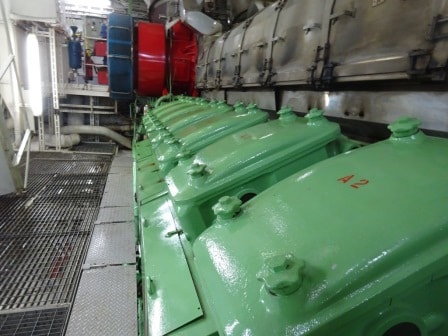
The top of one of the engines. The cylinders are arranged in V shape and thus the covers are under an angle as well. The red drum at the far end is the Turbo Blower. Most cars have a turbo, the ships have them as well.
Today I did some review work in the engine room of the Oosterdam. The construction of the Vista Class is an evolution of the S class and the R class but with a big step. This was the first class with two separate engine rooms. In the 90’s the regulators were starting to get worried about the size increase of the cruise ships and having that whole ship rely on one engine room. It would only take a small fire and the whole technical heart of the ship would be out of service. Thus came the idea to split up the engine room in two parts and have two or three engines in one compartment and two or three in another. As all the new ships were Diesel Electric this was very easy because they did not need a connection to the propeller shafts. Only a few electric cables are needed to go from the engines generator to the transformers and those transformers could be located anywhere in the ship if needed.
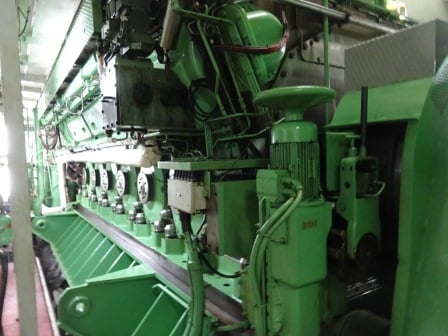
The engines run three decks high. This is D deck level. Then the real foundation is another 5 feet down towards the bottom of the ship. The round eyes sticking out were used for lowering the engine into the ship by a crane during the construction of the ship.
The Oosterdam is number 3 of the Vista Class and thus has a Forward and an Aft Engine Room. Forward there are 2 engines with a Gas Turbine engine in between and the aft one has three 3 engines. Three of them have 16 cylinders and two of them have 12 cylinders. The Gas Turbine was a bright idea before 2010 and they were installed in quite a few ships between 2000 and 2010. The Queen Mary has one as well as an example. The idea was that if you needed some extra speed then you could use the turbine which would have less maintenance and a lot less weight than a normal engine and could produce the same or more output.
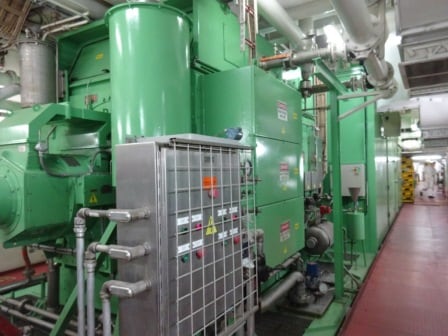
On board the jet engine turbine is completely sealed away in a protective housing. It produces a power of 11000 volts and you do not want to get close to that.
At that time the price for the fuel it needed was still low and thus it was economically feasible and operationally a nice perk. As we know the fuel cost rocketed after 2008 and then jet turbine became a sort of white elephant. The turbine is indeed similar to an airplane engine and thus we call it so. It is hardly used anymore and ships which were constructed with the emphasis on these jet turbines (Royal Caribbean had a few) received additional motor engines to bring the cost down. If we would run it now, then the chief engineer would have to go around collecting money first from the Guests before he could afford to start the machinery up.
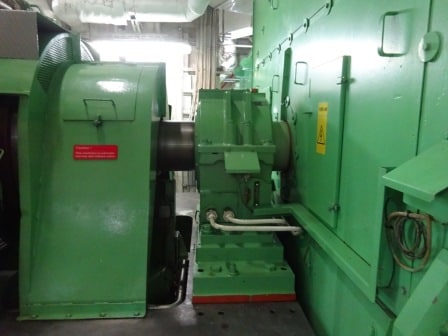
The engine is connected by a 12 inch thick shaft to a generator. Which is a sort dynamo and generates electricity.
Each engine is connected to a Generator which changes the shaft movement into electricity and that electricity then goes to Transformers which bring the power down to a current which can be used by a converter and this converter powers an Azipod which pushes the ship forward. Not all the power goes there; some is diverted and used for the ships operation. And when we go in and out of port, the bow thrusters run on electricity as well.
All ships are so configured that the average speed needed for a cruise can be handled by one engine less than the total on board and the engine not in use can then be put under maintenance. THis is done on a regular rotation; varying from small repairs and regular piston inspection, to a full stripping down of the whole engine when the maximum running hours have been reached. We take our cars to the garage after so many miles, a ships engine is completely taken apart while the ship is in operation. New parts come on board beforehand and the old –exchange- parts go ashore for refurbishment.
Tomorrow is the 2nd day of our crossing and now the question slowly arises what the weather will bring. As always it will all depend if there is no hurricanes coming over and staying south of Bermuda or a depression created off Cape Hatteras decides to drop down, instead of curving northwards and head directly for Iceland.
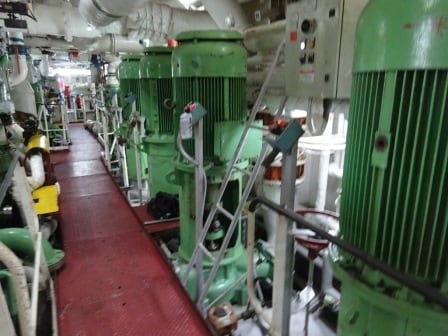

November 10, 2016 at 5:44 pm
Dear Captain Albert,
We have never met, although our paths crossed once, when you left MS Statendam in Vancouver at the end of September 2013 and we boarded as guests for the South Pacific Circle. I gather that the last day for you coming south from Alaska was a bit outside the usual routine. I was disappointed not to meet you having been a long time follower of your HAL blog. We were not short changed though, because we had Captain van der Wall (pronounced Wonderful) to show us that beautiful part of the globe.
My purpose in writing today is to thank you for all the insights that you provide into the hidden aspects of our cruise experiences and in particular this concise and informative explanation of where all the power comes from. Not for the first time, your post today has given me a much better understanding of what lies behind the “Crew Only“ doors.
So, thank you and I hope that we do meet on board a dam ship one day soon. Enjoy your sea days on the crossing. Wish I was there too,
Peter from Victoria.
November 11, 2016 at 7:03 pm
Captain Albert:
I have crossed the Atlantic on cruise ships now 4 times, and each time the Atlantic has been “like glass”. I feel cheated – this is not the true nature of the Atlantic, at least according to stories. Part of the cruise experience to me is feeling/watching a ship work her way through rough seas, not a “lake”. I’m sure most of your readers will not agree with me, but so be it…..Ruud